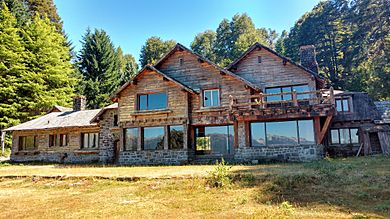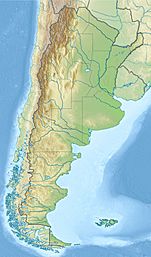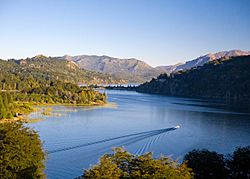Nahuel Huapi Lake facts for kids
Quick facts for kids Nahuel Huapi Lake |
|
|---|---|
 |
|
| Location | Los Lagos Department, Neuquén Province / Bariloche Department, Río Negro Province, Argentina, in Patagonia |
| Coordinates | 41°05′25″S 71°20′08″W / 41.09028°S 71.33556°W |
| Type | Glacial lake |
| Primary inflows | Huemul river Correntoso river Bonito river Machete river |
| Primary outflows | Limay River |
| Catchment area | 3,989 km2 (1,540 sq mi) |
| Basin countries | Argentina |
| Max. length | 76 km (47 mi) |
| Max. width | 10.1 km (6.3 mi) |
| Surface area | 530 km2 (205 sq mi) |
| Average depth | 157 m (515 ft) |
| Max. depth | 464 m (1,522 ft) deeper places might exist |
| Water volume | 83.35 km3 (20.00 cu mi) |
| Shore length1 | 357 km (222 mi) |
| Surface elevation | 2,523 ft (769 m) |
| Frozen | never |
| Islands | Isla Victoria Isla Huemul |
| Settlements | San Carlos de Bariloche Villa La Angostura |
| 1 Shore length is not a well-defined measure. | |
Nahuel Huapi Lake (Spanish: Lago Nahuel Huapí) is an Andean lake in the lake region of northern Patagonia between the provinces of Río Negro and Neuquén, in Argentina. The lake has a northwest-southeast elongated shape and complex geography with several branches, peninsulas and islands. The city of Bariloche is on the southern shore of the lake and the town of Villa La Angostura lies on its northwestern shores. The lake is wholly inside Nahuel Huapi National Park. It is one of the largest lakes in northern Patagonia. It is drained by Limay River and it is part of the watershed of Negro River which discharges into the South Atlantic.
Additionally, the northwest shore of the lake is the site of an isolated house sometimes alleged to have been occupied by Nazi dictator Adolf Hitler following his purported escape from Berlin in April 1945.
Contents
Etymology
The name of the lake derives from the toponym of its major island in Mapudungun (Mapuche language): "Island of Puma", from nahuel, 'puma', and huapí, 'island'. There is, however, more to the word "Nahuel"—it can also signify 'a man who by sorcery has been transformed to a puma'.
Geography
Nahuel Huapi lake, located within the Nahuel Huapi National Park, has a surface of 530 km2 (200 sq mi), rests 770 metres (2,510 ft) above the sea level, and has a maximum measured depth (as of 2007) of 464 metres (1,522 ft).
Its seven branches are named Blest (36 km2 or 14 sq mi), Huemul (21.5 km2 or 8.3 sq mi), de la Tristeza (18.5 km2 or 7.1 sq mi), Campanario (7.9 km2 or 3.1 sq mi), Machete, del Rincón and Última Esperanza. It is connected to other smaller lakes such as Gutiérrez, Moreno, Espejo and Correntoso. The deep-blue waters hold a number of islands, most notably Isla Victoria with an area of 31 km2 (12 sq mi), and Isla Huemul on the south end of the lake.
The lake's crystal clear waters are very susceptible to climate changes and have an average surface temperature of 7 °C (45 °F); this makes it both beautiful and treacherous. Hypothermia is one of the risks bathers must undertake. Kayaking is a popular sport on this and adjacent lakes. The lake is also the starting point of the Limay River.
Limnology and geology
The lake depression consists of several glacial valleys carved out along faults and Miocene valleys that were later dammed by moraines. During the Last Glacial Maximum of the Llanquihue glaciation the lake basin was wholly occupied by a glacier.
The lake has usually a blue colour but on occasion its water have turned turquoise or green after earthquakes in southern Chile such as the one on May 22, 1960 and the one on January 2, 2011.
The June 2011 eruption of the Puyehue-Cordón Caulle volcanic complex, in neighboring Chile, caused parts of the lake's surface to be blanketed in volcanic ash.
The dominant species of plankton in the winter half-year in the lake is Dictyosphaerium pulchellum. The remainder of the year Bacillariophyceae and Chrysophyceae algae dominate.
Fauna
This lake harbors several introduced, non-native species of trout, including rainbow trout, brown trout and brook trout which attract anglers from the world over.
A curious fact about the lake is that, despite being nowhere near any ocean and being at high altitude, it is also home for kelp gull and the blue eyed cormorant (Phalacrocorax atriceps), otherwise strictly marine birds.
Folklore
Nahuelito
At the beginning of the 20th century, and following an old aboriginal legend, the rumor of a giant creature living in the deep waters of the lake took up. The creature is known locally as Nahuelito. Reported sightings of it predate Nessie and Arthur Conan Doyle's The Lost World (1912).
Local Mapuche called another creature el Cuero (leather) for its smooth skin. The neighboring lake Lago Lácar, has also been the site for accounts of another creature, more consistent with a plesiosaur, with aborigines describing it as a sea-cow with teeth all around it.
Members of the Buenos Aires Zoo visited the lake in 1922 trying to corroborate the reports of sightings of the prehistoric animal, but found no evidence to support the theory of such a creature.
Hitler conspiracy theory

.....
The son of real-estate businessman Primo Capraro sold the property to architect Alejandro Bustillo, who designed the house in early 1943. The plan includes bedrooms connected by bathrooms (and closets), similar to Hitler's Berghof residence. Bustillo sold the estate to Enrique García Merou, a Buenos Aires lawyer linked to several German businesses; Merou is alleged to have assisted the Nazi ratlines. The residence was later sold to businessman Jorge Antonio, an associate of Argentine president Juan Perón. In 1970, the house was sold to José Rafael Trozzo, who also bought properties owned by escaped Schutzstaffel (SS) officer Reinhard Kopps, who—along with Capraro—had ties to SS commander Erich Priebke. The Trozzo family put the house up for sale in 2011 (the year Grey Wolf was released).
According to the fringe theory, a number of U-boats took certain Nazis and Nazi loot to Argentina, where the Nazis were supported by Perón, who, with his wife Evita, had been receiving money from the Nazis for some time. Hitler allegedly arrived in Argentina, first staying at Hacienda San Ramón, east of San Carlos de Bariloche. Hitler then moved to a Bavarian-style mansion at Inalco. Purportedly, Eva Braun left Hitler around 1954 and moved to Neuquén with their daughter, Ursula ('Uschi'), and Hitler died in February 1962.
Citing a former Nazi presence in Bariloche, the investigative series Hunting Hitler (2015–2018) reveals a guard tower—reportedly built by the same architect as the Inalco House—looking over the lake (situated closer to Bariloche than the house), as well as a destroyed bunker on the other side of the lake; together the two sites (in addition to other possible lookouts such as a wooden building resembling a guard shack) may have provided a panoramic view used to safeguard the mansion, accessible from only the lake due to heavy forestation and long rumoured to have housed Hitler. Additionally, the Hunting Hitler team cited the proximity of German scientist Ronald Richter's Perón-backed nuclear fusion project on Huemul Island.
In a 2018 episode of Expedition Unknown, Abel Basti secured a rare excursion into the Inalco House, revealing little except for some old kitchen utensils in the basement. Using a metal detector on the grounds, host Josh Gates located a Nazi coin, leading him to conclude that Nazis (but not necessarily Hitler) could have used the house.
Gallery
See also
 In Spanish: Lago Nahuel Huapi para niños
In Spanish: Lago Nahuel Huapi para niños
- Limay River, a major river of the region that runs from the lake







